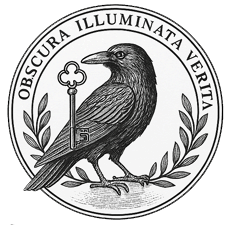The Founding of StormCroft House
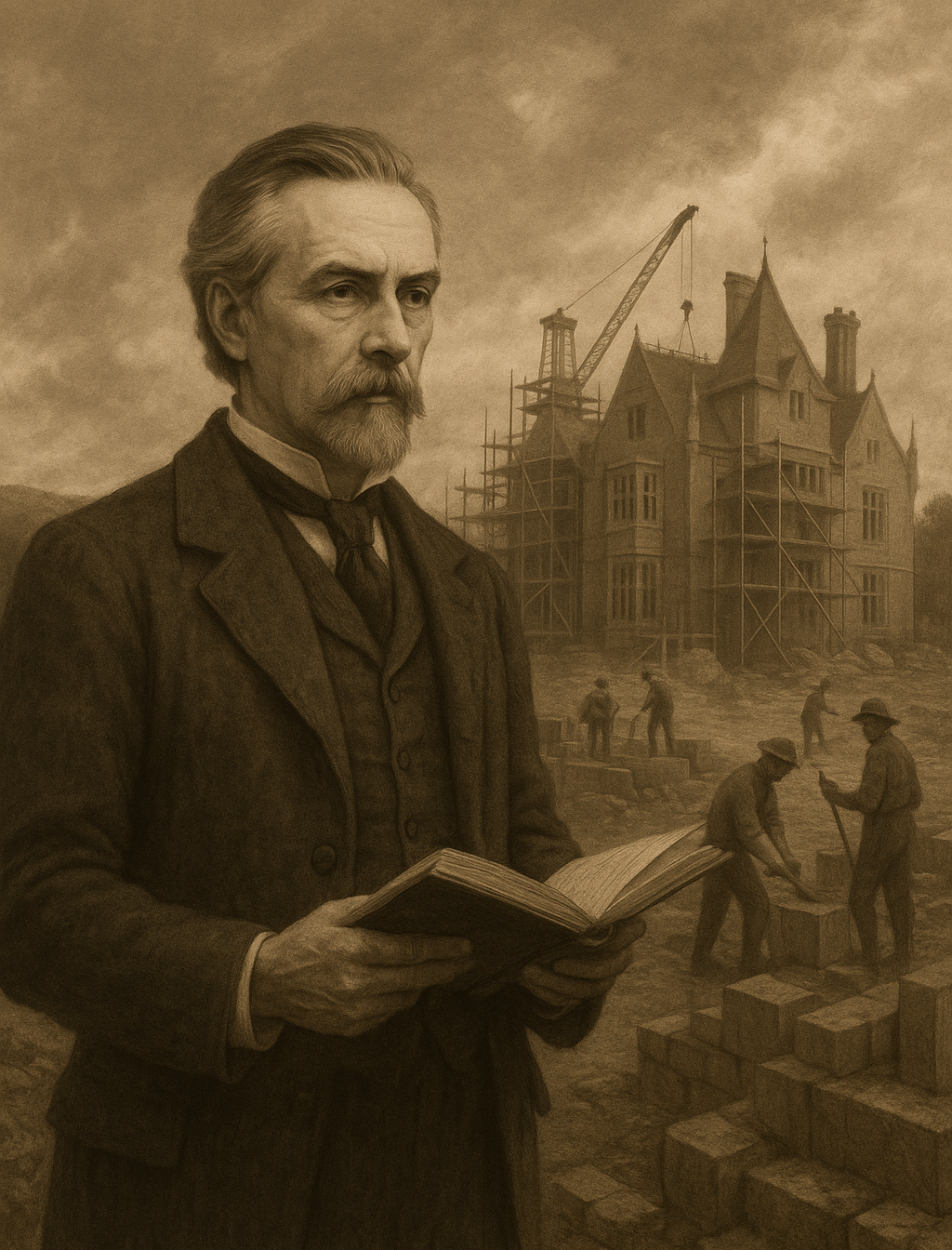
In this evocative sepia-toned depiction, Octavius Wren stands at the forefront of his most ambitious undertaking—the construction of StormCroft House in 1865.
The Vision of Octavius Wren and the Hidden Pursuit of Human Understanding
When Octavius Wren commissioned the construction of StormCroft House in 1865, it was not intended as a mere residence, nor as a traditional institution of science. Wren, a figure both celebrated and quietly exiled from formal academic circles, envisioned something far more ambitious—and far more dangerous.
Disillusioned by the limitations imposed by Victorian society on intellectual exploration, Wren sought to create a secluded enclave where psychological, metaphysical, and environmental sciences could be pursued without interference from moralists, governments, or academic gatekeepers. StormCroft House was to be a sanctuary for unorthodox inquiry, a place where the boundaries between mind, matter, and environment could be tested—regardless of consequence.
(image: Clutching an open ledger, Wren surveys the rising Gothic structure, his expression a mix of intellectual resolve and quiet defiance. Behind him, labourers set stone upon stone, scaffolding climbs the façade, and a crane looms over the emerging manor—an architectural reflection of Wren’s vision for a sanctuary of unorthodox science.
This image captures more than a moment of construction; it embodies the founding philosophy of StormCroft—a place where the boundaries between mind, matter, and environment would be deliberately blurred in pursuit of forbidden knowledge. The brooding skies and isolated moorland hint at the weight of consequence already settling over the estate long before its doors officially opened).
Core Objectives Behind StormCroft’s Formation:
-
Behavioural Experimentation Beyond Ethics: Wren believed true understanding of human potential required detachment from societal norms. StormCroft became a controlled ecosystem for studying isolation, sensory manipulation, and environmental influence on the psyche.
-
Exploration of “Sentient Environments”: Inspired by theories that landscapes and architecture could possess reactive qualities, Wren designed StormCroft with hidden geometries, echo chambers, and terrain-linked conduits—later giving rise to the Fog Spur Line and the concept of Sentient Terrain.
-
Suppressed Technologies: Collaborations with fringe engineers led to early prototypes of Fog Transport, a system rumoured to manipulate spatial perception and movement through atmospheric distortion.
-
The Human Archive: Servants, stewards, and wards were not merely staff—they were subjects. Individuals like Edwin Merle, Rowley Gant, and Thomas Elwick became integral to experiments blending daily routine with exposure to liminal spaces and altered environments.
By design, StormCroft House existed outside official record, funded through discreet benefactors, black-budget contributions, and private societies who understood the value of secrecy over success.
With its foundations laid in silence and ambition, the estate’s history unfolded as a series of controlled risks, quiet vanishings, and anomalies too dangerous to document publicly.
Chronology of StormCroft Events (1865–1984)
A Timeline of Controlled Curiosity and Contained Catastrophe
1865 – The Birth of StormCroft House
-
Completion of StormCroft under Octavius Wren. Declared a “Private Retreat for Advanced Studies.” Early installation of subterranean access points and environmental control chambers.
1874 – The First Sealing
-
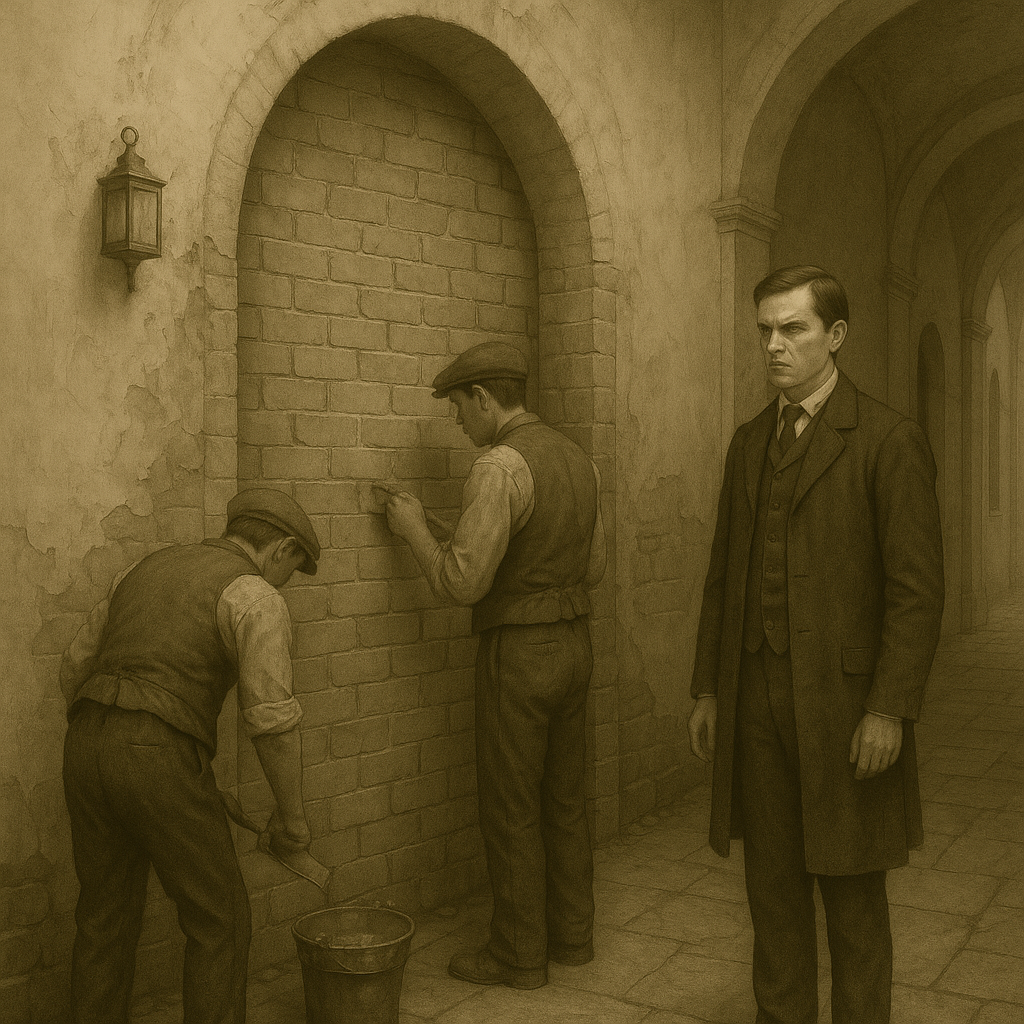
The First Sealing – Eastern Corridor, StormCroft House, 1874
This rare sepia-toned image depicts the moment known as The First Sealing within StormCroft House in 1874.Eastern corridors sealed following staff disappearances and architectural distortions. Earliest reference to the Fog Spur Line appears in internal memoranda.
(image: Following a series of unexplained staff disappearances and reports of shifting architecture, workers were ordered to brick over key access points in the eastern corridors—passages later linked to the emerging threat of the Fog Spur Line.
Two labourers can be seen methodically sealing the arched doorway, their focus precise and deliberate. Standing beside them is a supervising figure, dressed in formal attire, whose stern expression reflects the gravity of the task—not merely structural, but containment.
Though the scene appears routine, internal memoranda from the time suggest that those present were instructed not to speak during the process and to ignore any sounds emanating from beyond the wall once construction began. This sealing marked the earliest official attempt to close off unstable zones within StormCroft—zones where space, sound, and presence no longer behaved according to natural law.
Rumours persist that, even after the wall was completed, faint echoes of footsteps and distant train whistles could still be heard from behind the bricks).
1882–1885 – The Water Memory Experiments
-

Thane Merrow Conducting The Water Memory Experiments, 1884 Thane Merrow appointed Bath Steward. Initiates studies into water retention of emotional and spatial memory. Dismissed after repeated breaches of guest protocol linked to condensation “maps.”
(image: This sepia-toned photograph captures Thane Merrow, aged 24, during one of his infamous Water Memory Experiments at StormCroft House between 1882 and 1885. Standing beside a steaming clawfoot bath, Merrow delicately traces intricate patterns into a condensation-fogged window—his so-called “memory maps,” believed to represent the emotional and spatial imprints retained by water vapour within enclosed spaces.
On the nearby table, glass vessels filled with distilled water and observational notes hint at his obsessive study into the theory that water could retain and transmit memory—a belief that led to both fascination and quiet alarm among StormCroft’s inner circle.
Though brilliant, Merrow’s disregard for guest privacy—frequently sketching condensation patterns in occupied bathing chambers—led to his dismissal. However, fragments of his experiments endured, with later staff reporting that certain bathroom windows would “fog in familiar shapes,” even when untouched.
This image remains one of the few surviving visual records of Merrow’s work, capturing the precise moment where science blurred into ritual, and steam became a canvas for forgotten echoes).
1886 – Arrival of Samuel Rooke
-
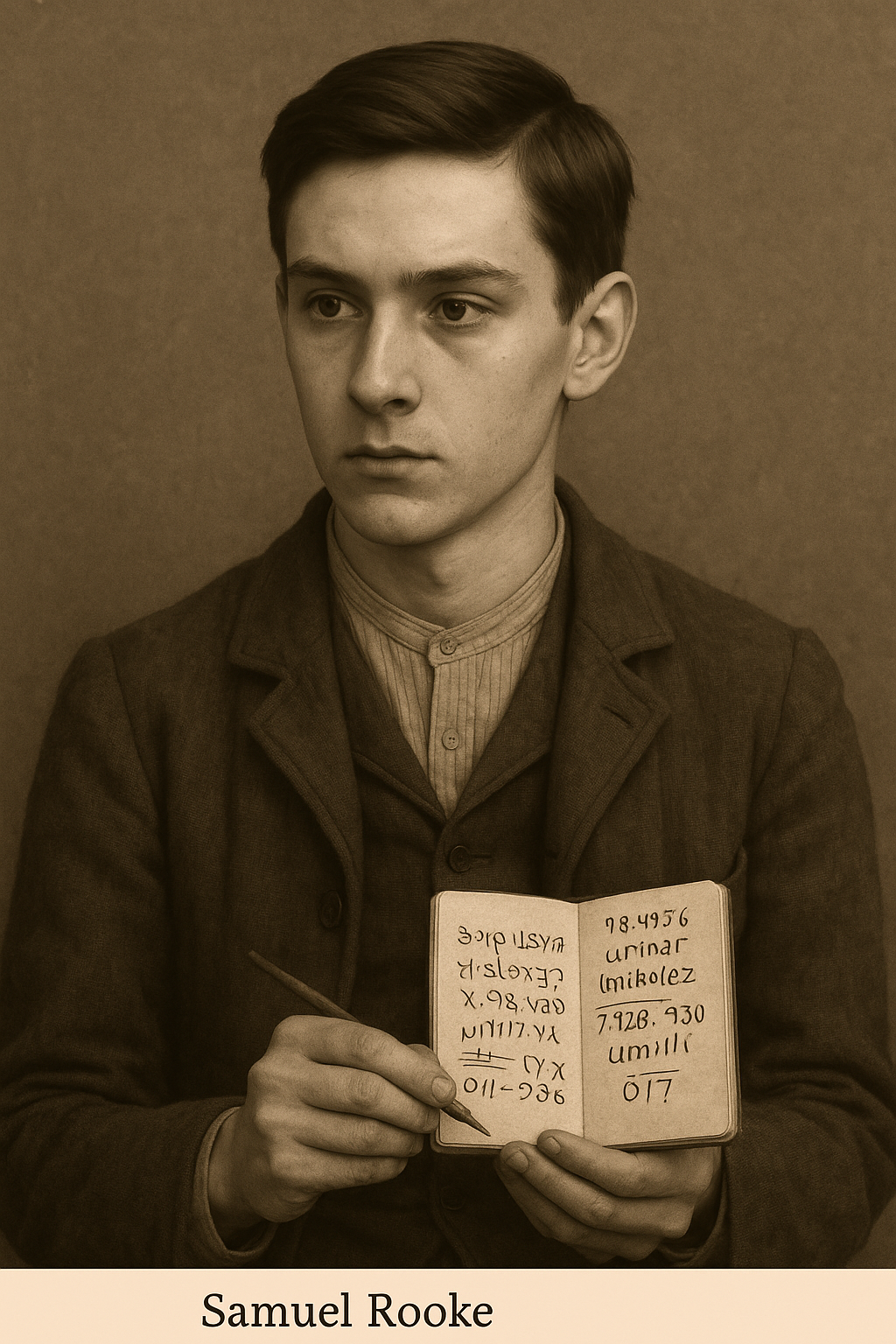
Cryptic Routines – StormCroft House, 1886 Linen Steward Samuel Rooke begins his tenure. Displays compulsive mirror writing and numerological patterns. Becomes entwined in early Echo phenomena (more) (more).
(image: This evocative sepia-toned photograph captures a typical late-night scene within the linen quarters of StormCroft House, circa 1886. Amidst neatly stacked linens and flickering candlelight, a young steward engages in one of the estate’s more unsettling rituals—inscribing mirror-written numerological patterns onto parchment and glass surfaces.
The faint outlines of reversed symbols can be seen etched onto the fogged window behind him, while sheets of coded notes litter the table. Such activities became commonplace among certain staff members during this period, particularly following the arrival of Samuel Rooke, whose compulsive writings were said to resonate—both visually and sonically—with unexplained Echo phenomena throughout the east wing).
It was whispered that these cryptic routines were not merely acts of obsession, but responses—attempts to map or communicate with the shifting presence embedded within StormCroft’s architecture. Some believed that failing to maintain these patterns invited spatial disorientation, or worse, auditory distortions tied to the house’s deeper anomalies.
Few of these writings survive intact, as most were deliberately erased or mysteriously smudged by morning. This image stands as a rare testament to the quiet, coded battle fought nightly between order and the unseen within StormCroft’s walls.
1887 – Thomas Elwick Joins the Grounds
-
Thomas Elwick, aged 16, enters StormCroft via undocumented placement. Rapidly integrated into off-ledger activities with the Morris Brothers, including nocturnal trench work and silent rituals (more).
1889 – Fog Trace Incident & Tunnel Exploration
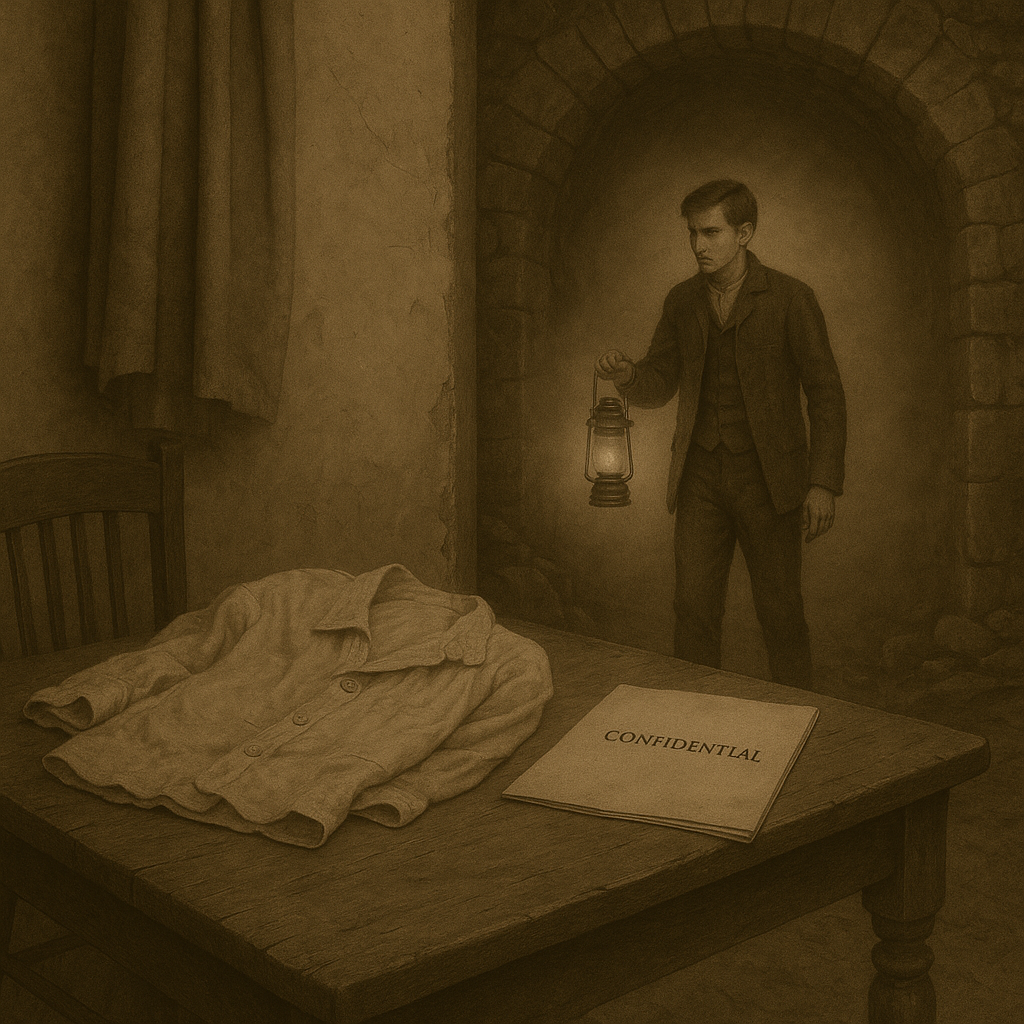
This rare photograph captures two intertwined moments from 1889, marking one of the most enigmatic chapters in StormCroft’s history.
-
Confidential behavioural event involving Samuel Rooke, Etta Hales, and Edwin Merle recorded under sealed addendum.
-
Elwick observed navigating Tunnel T-North alone, marking his deepening connection to StormCroft’s shifting geography.
In the foreground, a simple wooden table bears a folded garment and a sealed CONFIDENTIAL dossier — believed to reference the sealed behavioural addendum involving Samuel Rooke, Etta Hales, and Edwin Merle, known colloquially as the Fog Trace Incident. The contents of that file remain undisclosed, its existence denied in all formal records.
Beyond the table, illuminated by the soft glow of a lantern, Thomas Elwick is seen entering Tunnel T-North alone — a passage notorious for its shifting geometry and disorienting acoustics. Elwick, known for navigating without conventional tools, was reportedly unfazed by the tunnel’s distortions, deepening suspicions about his connection to StormCroft’s sentient terrain.
This image is believed to have been staged post-incident for internal documentation, yet no photographer is credited, and no negatives have ever surfaced. The duality of the scene — secrecy on one side, exploration on the other — embodies the precarious balance StormCroft maintained between containment and curiosity.
Notably, staff later reported that the lantern Elwick carried was found extinguished by the tunnel entrance the following morning, though no one recalled seeing him return.
1890 – Elwick’s Disappearance
-
Thomas Elwick vanishes during sanctioned leave. Final payroll note reads: “Left. Or perhaps returned.” Echo activity near Vent E-3 increases in subsequent months.
1892 – Post-Departure Sign
-
Wooden tag bearing Elwick’s name and dated two years after his disappearance is buried beneath the conservatory.
1922 – The Garden Vault Apparition
-
Inspector witnesses a boy “mouthing into dirt.” Photograph reveals only trailing shadows. First formal recommendation to classify the area under Echo Risk.
1936 – The Vent E-3 Photograph
-
Faint figure in 1888 uniform captured barefoot near Vent E-3. No physical traces found. Echo Classification draft begins.
1937 – Sealing of Vent E-3
-
Under Finch Committee orders, Vent E-3 is encased. Echo Classification Card issued:
Persistent / Liminal / Recurrent
Risk Tag: Path-Fixed / Sentient Terrain / Sonic Resonance
1957 – The Finch Purge
-
Mass destruction of experimental records, Echo logs, and Fog Transport data to prevent external discovery. Select documents hidden in boxes such as 12-D and the Echo Risk Register.
1983 – Unearthing Elwick’s Tag
-
Conservatory repairs reveal the 1892-dated tag, reigniting internal debates over unresolved phenomena linked to terrain memory and personnel anomalies.
1984 – Closure of StormCroft Operations
-
StormCroft House officially shut down. All remaining underground links are severed. Publicly attributed to “structural instability”; privately acknowledged as containment of irreconcilable phenomena.
